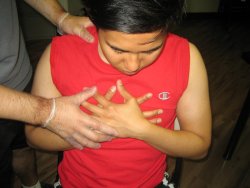
Referred chest pain is a medical term that is commonly used to refer to a kind of pain in the chest that emanates from the back. This means that the pain that is experienced at the chest cavity is a manifestation of a problem in one’s thoracic spine. Referred chest pain is thus, a pain felt in the chest but whose cause comes from the back site of an individual’s thorax. A thoracic spine in this case refers to the area of the spine that runs between one’s shoulder blades down the mid-back.
The material posted on this page on circulatory emergencies and managing pain is for learning purposes only. To learn to recognize and manage breathing and circulatory emergencies sign up for a first aid and CPR course today.
Referred Chest Pain Symptoms
Various symptoms have been brought forth to explain referred chest pain and to differentiate it from other types of chest pains. These symptoms include but are not limited to pain in the chest region which comes on without a traumatic injury to the chest area. In addition, the pain may be made worse when the patient takes deep breaths, coughs or sneezes. Other symptoms of referred chest pain are a feeling of stiffness at the upper back area, and a feeling of tenderness and tightness of the upper back muscles.
Causes of Referred Chest Pain
Referred chest pain can be caused by almost every structure that is found in the chest. Notably, different organs in the body can produce different types of pain. However, these kinds of pains are not specific to each cause. This pain can be as a result of an inflammation due to stretching or distention of an organ for instance, blockage of the small intestine, or by a loss of blood supply to an organ.
Treatment
Since this kind of chest pain is mostly common in young athletes, it is important to determine the cause of the pain before treating referred chest pain. However, the treatment of referred chest pain commonly include deep tissue massage and a spinal handling to reinstate full range of movement to the joints in the backbone. In addition, another treatment technique entails performing stretching and strengthening exercises in order to get back full movement and power.
Referred chest pain Prevention
A patient may strive to prevent referred chest pain by improving on his or her fitness, strength and flexibility by learning and practicing proper techniques for work, sports and even rest. The ordinary movement of the neck and shoulder depends on the normal mobility of one’s upper thoracic spine. Always strive to avoid strains in the muscles and joints around the shoulder, neck and shoulder blades that can cause referred chest pain. Perform adequate warm up and exercises regularly and before any training to prevent the possibility of suffering from referred chest pain. Besides, avoid prolonged driving or sitting with a poor posture and avoid smoking. Lastly, it is always necessary for individuals to maintain a healthy weight at all times because an overweight person is more prone to referred chest pains than a healthy person.
